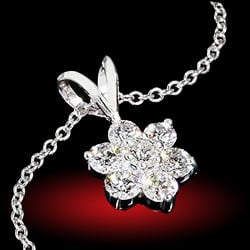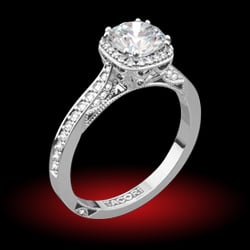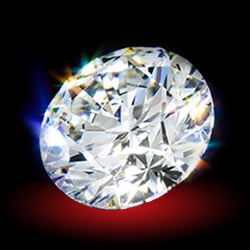- Joined
- May 25, 2005
- Messages
- 538
Here is our FAQ-101 for precious gems in custom-made jewelry. It is meant to cover the very basic for the beginner or the one-time user.
What material?
Gold
Most mass-produced jewelry is done in 14k, or still worse in 8k. It looks terrible after a year or two; wears down; and turns dull and lusterless. 14k or less is not for real gemstones.
22k is beautiful but too soft for jewelry.
18k is the sweet point. It keeps the shine for years and is strong enough to protect the gem.
Today, you may also choose from a variety of hues: Pink gold, rose, even purple or green are on offer. Prices will be slightly higher for exotic mixes (like 10-20%).
Platinum is the prime choice for high-end gemstones. It is heavier and more expensive than gold; and it is also more demanding to work with. Not all goldsmiths can do it. It never looses luster and does not wear down. Estimate to at least double the cost from 18k gold to platinum.
Silver is not much used for individual settings anymore. It is not sufficiently strong and durable for precious gems. Even if you wanted to use silver it is not easy to find good silversmiths.
There are other materials like steel, wood or cotton that experienced jewelry artists work with, but they are not a first choice for precious gemstones.
Bezel or prongs?
Prongs lead the pack. They are delicate, offer many design varieties and show the most of any gem, its luster, color and size.
However, they get do caught in stuff, bend open and loose gems; oh horror.
If you do go for prongs, make sure they don’t stand out. The finger tip should run smoothly over each prong’s end and back. Try to hook up your favorite shirt before you go out. Better then than later.
Bezels are the safest type of setting but they are also more expensive, need more material and extra work. For battered jewelry (rings and bracelets) in active lifestyles we recommend bezel settings.
Swap-Anxiety
If you fear being ripped-off by a goldsmith, there is only one way for you: Ready-made jewelry.
People are unnecessarily worried here. Within the limits of human predictability no goldsmith will risk jail-time to pinch some gemstones. As much as car repair shop doesn’t steal cars. It just isn’t a profitable business model.
The thorough mind may use inclusions to identify any gem. Inclusions are like fingerprints and can not be copied. Every natural gem has inclusions visible latest under a 30x magnification. In most cases you will only need a handheld 10x loupe ($25) to check the authenticity of your gem before and after setting. Take a good, deep look. Lacking photographic memory you can make a sketch of the gem’s inner landscape: Five needles sitting in the upper left corner, a fracture in the second upper facet and an oval-shaped cloud in the lower center - you can be sure to indentify your gem anytime.
Chains
Hand-made chains are very expensive and generally too gangsterish for a conservative scenery. Chains from a real goldsmith can be $10k and then some.
If you want something special you can order high-end chains made in Swiss or Germany. They are exquisite and come in various designs and materials. A fine gemstone pendant deserves a fine chain. Calculate at least $1k for a high-end gold chain and 3k for platinum.
Regardless of your budget, it is recommended to source the chain after the pendant is done. With pendant in hand it is much easier so find a perfectly matching chain.
Chinese machine-made chains should not cost much more than the material plus some margin for the trade. Think of very few hundred dollars for good-enough quality, but don’t penny-pinch or your pendant will be gone one day.
Damage of stones
This happens but you can not ask the goldsmith to cover the risk. Ask the seller to take the risk for his stone. Again, if you can’t trust your goldsmith forget about it. See also here.
How long?
A dedicated goldsmith can make a standard setting in a day’s work if all is well prepared. More time is needed for logistics and creative work. A realistic turn-over for an individual but familiar design at the bench is a week (plus international shipments). If it is your first time and you plan a Christmas present or an important yes-or-no-question start a few months ahead.
How many carats?
Well, that all depends.
As a rule, the smaller the gem the more luster it will need to be visible; the bigger a gem, the more will its color be important.
After a few project you get a good personal feeling for carats and dimensions.
The totally inexperienced may check the following sign posts:
0.2 carat is tiny - hardly big enough as stand-alone gem in jewelry.
0.4 carat is still tiny for most occasions but in a terrific quality and in an equally delicate design it may just become visible.
0.8 can be considered as a solitary ring gem but, again, you need good quality; and some diamonds will help.
1-3 carat is the standard go-to size for a ladies ring and the smallest size for a pendant.
3-6 carats can be opulent in a ladies ring, perfectly sized in a gents ring and make a still modest pendant.
6-10 carat makes a big stone, needing full ring sizes, heavy designs, and the willingness to bear the weight (and the cost). Ten carats are probably not every-days choice in a ladies ring but can be worn on special occasions. In pendants ten carats will be very visible but not yet bulky.
Over 10 carats we enter the world of posh pendant-only jewelry. Citrine or Topaz is sometimes seen in 20+ carat sizes but heavy-weight precious gems are rare in jewelry (without bodyguards).
For cabochons double the scale. Less than one carat in a cabochon is small. 10 carat cabochons are still good measure.
Disclaimer: Honestly, there are a million things to learn. But don’t be discouraged. It is much more rewarding to create good quality hands-on that buying bad quality hands-off. If you do not want to make any mistakes on your first project, set two carats in an 18k gold bezel and little can go wrong.
What material?
Gold
Most mass-produced jewelry is done in 14k, or still worse in 8k. It looks terrible after a year or two; wears down; and turns dull and lusterless. 14k or less is not for real gemstones.
22k is beautiful but too soft for jewelry.
18k is the sweet point. It keeps the shine for years and is strong enough to protect the gem.
Today, you may also choose from a variety of hues: Pink gold, rose, even purple or green are on offer. Prices will be slightly higher for exotic mixes (like 10-20%).
Platinum is the prime choice for high-end gemstones. It is heavier and more expensive than gold; and it is also more demanding to work with. Not all goldsmiths can do it. It never looses luster and does not wear down. Estimate to at least double the cost from 18k gold to platinum.
Silver is not much used for individual settings anymore. It is not sufficiently strong and durable for precious gems. Even if you wanted to use silver it is not easy to find good silversmiths.
There are other materials like steel, wood or cotton that experienced jewelry artists work with, but they are not a first choice for precious gemstones.
Bezel or prongs?
Prongs lead the pack. They are delicate, offer many design varieties and show the most of any gem, its luster, color and size.
However, they get do caught in stuff, bend open and loose gems; oh horror.
If you do go for prongs, make sure they don’t stand out. The finger tip should run smoothly over each prong’s end and back. Try to hook up your favorite shirt before you go out. Better then than later.
Bezels are the safest type of setting but they are also more expensive, need more material and extra work. For battered jewelry (rings and bracelets) in active lifestyles we recommend bezel settings.
Swap-Anxiety
If you fear being ripped-off by a goldsmith, there is only one way for you: Ready-made jewelry.
People are unnecessarily worried here. Within the limits of human predictability no goldsmith will risk jail-time to pinch some gemstones. As much as car repair shop doesn’t steal cars. It just isn’t a profitable business model.
The thorough mind may use inclusions to identify any gem. Inclusions are like fingerprints and can not be copied. Every natural gem has inclusions visible latest under a 30x magnification. In most cases you will only need a handheld 10x loupe ($25) to check the authenticity of your gem before and after setting. Take a good, deep look. Lacking photographic memory you can make a sketch of the gem’s inner landscape: Five needles sitting in the upper left corner, a fracture in the second upper facet and an oval-shaped cloud in the lower center - you can be sure to indentify your gem anytime.
Chains
Hand-made chains are very expensive and generally too gangsterish for a conservative scenery. Chains from a real goldsmith can be $10k and then some.
If you want something special you can order high-end chains made in Swiss or Germany. They are exquisite and come in various designs and materials. A fine gemstone pendant deserves a fine chain. Calculate at least $1k for a high-end gold chain and 3k for platinum.
Regardless of your budget, it is recommended to source the chain after the pendant is done. With pendant in hand it is much easier so find a perfectly matching chain.
Chinese machine-made chains should not cost much more than the material plus some margin for the trade. Think of very few hundred dollars for good-enough quality, but don’t penny-pinch or your pendant will be gone one day.
Damage of stones
This happens but you can not ask the goldsmith to cover the risk. Ask the seller to take the risk for his stone. Again, if you can’t trust your goldsmith forget about it. See also here.
How long?
A dedicated goldsmith can make a standard setting in a day’s work if all is well prepared. More time is needed for logistics and creative work. A realistic turn-over for an individual but familiar design at the bench is a week (plus international shipments). If it is your first time and you plan a Christmas present or an important yes-or-no-question start a few months ahead.
How many carats?
Well, that all depends.
As a rule, the smaller the gem the more luster it will need to be visible; the bigger a gem, the more will its color be important.
After a few project you get a good personal feeling for carats and dimensions.
The totally inexperienced may check the following sign posts:
0.2 carat is tiny - hardly big enough as stand-alone gem in jewelry.
0.4 carat is still tiny for most occasions but in a terrific quality and in an equally delicate design it may just become visible.
0.8 can be considered as a solitary ring gem but, again, you need good quality; and some diamonds will help.
1-3 carat is the standard go-to size for a ladies ring and the smallest size for a pendant.
3-6 carats can be opulent in a ladies ring, perfectly sized in a gents ring and make a still modest pendant.
6-10 carat makes a big stone, needing full ring sizes, heavy designs, and the willingness to bear the weight (and the cost). Ten carats are probably not every-days choice in a ladies ring but can be worn on special occasions. In pendants ten carats will be very visible but not yet bulky.
Over 10 carats we enter the world of posh pendant-only jewelry. Citrine or Topaz is sometimes seen in 20+ carat sizes but heavy-weight precious gems are rare in jewelry (without bodyguards).
For cabochons double the scale. Less than one carat in a cabochon is small. 10 carat cabochons are still good measure.
Disclaimer: Honestly, there are a million things to learn. But don’t be discouraged. It is much more rewarding to create good quality hands-on that buying bad quality hands-off. If you do not want to make any mistakes on your first project, set two carats in an 18k gold bezel and little can go wrong.







300x240.png)